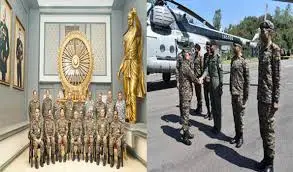Operation Sindoor aftermath: Emphasis on vigilance, synergy as CDS conducts strategic review at Northern, Western commands

After Operation Sindoor, India’s defence forces have intensified their efforts to boost vigilance and improve coordination between key military commands. The Chief of Defence Staff (CDS) recently conducted a strategic review of the Northern and Western Commands. This review aimed to sharpen readiness and enhance cooperation amid changing security challenges.
Operation Sindoor Sparks Renewed Focus on Border Security
Operation Sindoor was a major step toward strengthening India’s border defences, particularly along the Line of Control (LoC) and the Western frontier. The operation aimed to reinforce India’s deterrence and surveillance abilities. It ensured that potential threats would be detected and addressed quickly.
Following the operation, defence leaders reevaluated existing protocols. They also invested in technological upgrades. They realized that vigilance requires more than just troop presence. Integrating intelligence, surveillance, and reconnaissance assets is essential.
Defence experts say Operation Sindoor revealed some communication gaps between the Northern and Western Commands. The CDS acted on this by ordering a thorough review to close any operational vulnerabilities.
CDS Strategic Review: Focus on Vigilance and Cooperation
The CDS’s visit to the Northern and Western Commands was more than an inspection. It was a strategic assessment designed to align efforts across these important sectors. The Northern Command covers the volatile borders with Pakistan and China. The Western Command oversees key sectors in Rajasthan and Gujarat. Both play crucial roles in India’s defence.
During the review, the CDS focused on several areas:
- Upgrading Surveillance and Intelligence Sharing: The CDS highlighted the need to improve surveillance tools. This includes advanced drones, ground sensors, and electronic warfare systems. He stressed the importance of real-time data sharing to maintain situational awareness and quick responses.
- Increasing Joint Training: To boost cooperation, the CDS ordered more joint exercises. These drills simulate real combat scenarios. They help improve the coordination and communication between units.
- Improving Logistics and Mobility: The CDS noted that moving troops and supplies quickly is vital. He called for better infrastructure, such as roads and communication networks, to enable fast deployment.
- Boosting Troop Welfare: The CDS recognized the harsh conditions soldiers face. He stressed the importance of better living conditions, healthcare, and psychological support to maintain morale and readiness.
Vigilance is Key in a Complex Security Environment
India’s border security situation remains complicated and unpredictable. Clashes and tensions occur along both the LoC and the Western borders. The CDS’s review reflects the need for constant readiness.
Experts say Operation Sindoor highlighted the need to modernize faster. It also showed how vital it is to combine technology with traditional defence methods. The review emphasized the growing role of cyber defence, electronic intelligence, and satellite surveillance.
Moreover, the CDS pointed out that vigilance is not just a military job. It requires cooperation among border forces, intelligence agencies, and local authorities. This teamwork helps prevent threats before they escalate.
Enhancing Synergy Between Northern and Western Commands
One key result of the CDS’s review was the focus on improving cooperation between the Northern and Western Commands. These commands have traditionally operated independently due to different challenges. However, modern warfare requires unified strategies.
The CDS called for:
- Standardized Communication: All units must be able to communicate seamlessly during joint operations.
- Tactical Intelligence Sharing: Real-time sharing of intelligence will help coordinate patrols and counter infiltrations.
- Collaborative Planning: Joint planning will prepare the commands to respond quickly and effectively to any threat.
This approach will create a force multiplier, allowing the armed forces to act with greater speed and precision.
Modernizing Capabilities After Operation Sindoor
The aftermath of Operation Sindoor has accelerated efforts to modernize defence forces along both fronts. The CDS highlighted ongoing projects to:
- Deploy More UAVs: Drones provide constant surveillance over tough terrain and risky areas where manned patrols are difficult.
- Enhance Electronic Warfare Systems: These systems disrupt enemy communications and radars, giving Indian forces a tactical edge.
- Upgrade Artillery and Armored Units: New artillery systems with improved accuracy and range are being introduced.
- Develop Border Infrastructure: Roads, bridges, and logistics hubs are improving to support quick troop movements.
These upgrades will help India maintain a technological advantage while adapting to new warfare methods.
Regional Stability and India’s Strategic Posture
Operation Sindoor and the CDS’s review send a strong message. India is committed to protecting its sovereignty and ensuring regional stability. The emphasis on vigilance and cooperation supports a defence policy that balances deterrence with diplomacy.
Analysts believe this proactive stance strengthens India’s position in border talks. It also deters adversaries by demonstrating a credible and ready military force.
Conclusion
Operation Sindoor’s aftermath marks a critical phase in India’s defence strategy. It features increased vigilance, stronger cooperation, and faster modernization. The CDS’s review of the Northern and Western Commands highlights the importance of joint operations and advanced technology.
As India continues to secure its borders, the lessons from Operation Sindoor will guide future policies. They will ensure the armed forces remain agile, resilient, and ready to defend the nation at all times.






